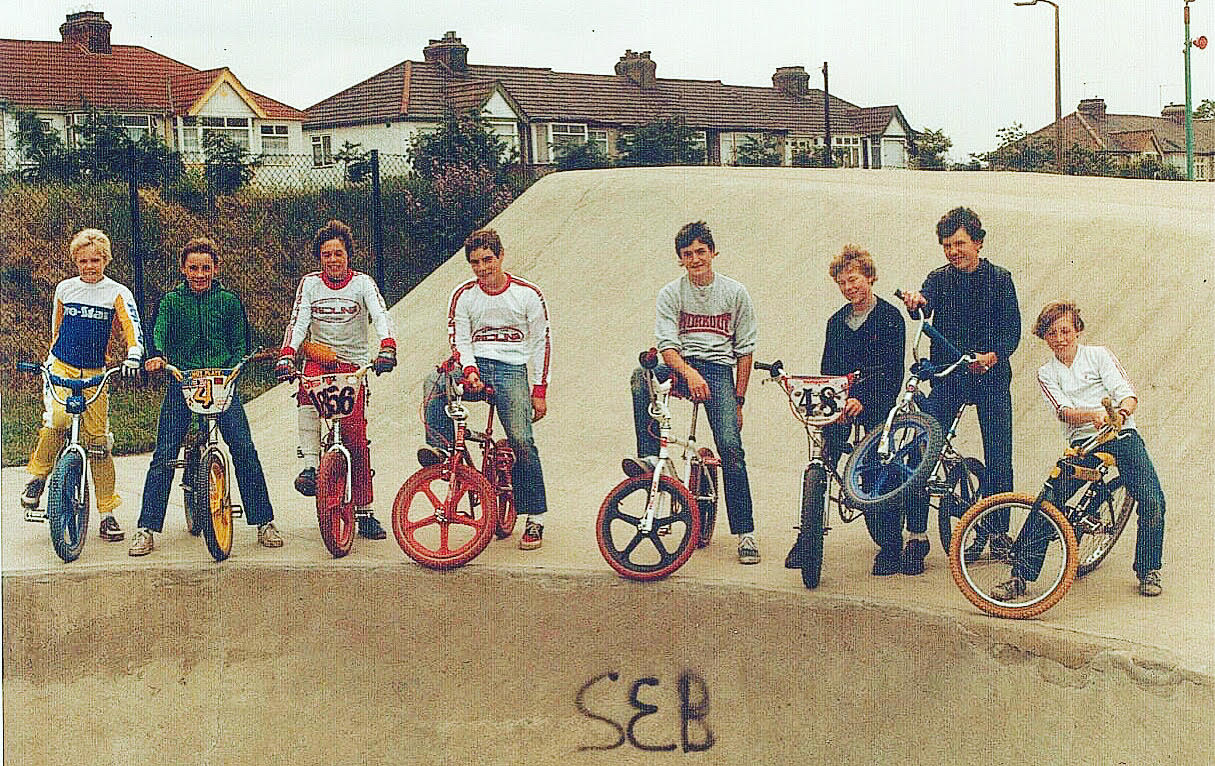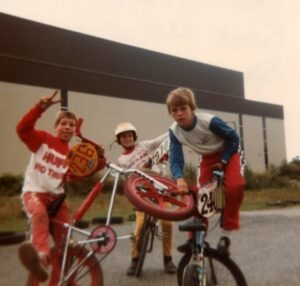
We Were Rad
Next week pre-orders of We Were Rad will begin sending out to hundreds of BMX fans. From a cut and paste zine to a 450 page hardbound book, the project has taken 5 years and thousands of memories to complete. It’s an idea started by Antony, Clint and Andy to preserve the real stories of BMXing from the kids who lived it but never had their moment in the spotlight. The book follows stories through the 80’s of bikes, fashion, competition and family with images and interviews throughout. It’s about being rad, not just for the couple of hours you were let out with your mates but forever. We spoke with Antony from WWR to learn more about the process of the book and why BMX culture has never really changed all these years later.
Interview and text by Esta Maffrett | 28.01.2022

The real story of BMX from those that lived and loved it. That’s the introduction to We Were Rad, a project run by Antony, Clint and Andrew to archive the everyday memories from British BMX culture in the eighties. Antony tells me the story of how it came to be, ‘in 2016 as part of a BMX event me, the two boys and some other guys put together an old school BMX zine which was very cut and paste, done on a photocopier… I got to interview two of my childhood heroes, the biggest guys in BMX really, Bob Haro who's the godfather of freestyle BMX. He was in the movie ET. And then probably the biggest name in British BMXing in the eighties Andy Ruffell. He was a great racer, freestyler and a TV personality. He was on Ready Brek adverts and Blue Peter, he was the cheeky Essex chappie. For me to interview those two guys, it was massive.’ The opportunity to interview childhood heroes and the positivity that the zine was met with showed the boys they could do something bigger. ‘There's always been lots of old pictures of the pros, and the famous people, professional shots. But nobody had told the story of the kids on the streets, which was our story. We all wanted to be Andy Ruffell and Bob Haro but we didn't have the budget. It was that time sort of five or six years ago, social media groups like Facebook and Instagram were transferring from forums and all these old photos had started to appear.’ The photos being scanned online were amazing to look at but their story was being lost in the void of the internet, We Were Rad could do something about that because they understood the value of those personal pictures. It makes sense, your first bike is a big moment for kids across decades and generations, we can all feel transported to a simpler time by the images in the archive because despite some of the aged fabrics, there is a timelessness in the gleeful faces of the kids. ‘It’s an emotional history of those times. Because there's so much fun and nostalgia of a carefree attitude.’
It’s an important insight of eighties Britain to be preserved with it’s backdrop remembered for individualism and increasing distrust against one another. Sports means being competitive but also admiring skill and respect in rivalry. ‘The cliched 80’s Thatcherite Britain is the time of the yuppies, the haves and the have nots, racism was a big thing and sexism. One of the narratives of the book is the inclusivity of BMX, how people of all ages, all genders, all races and backgrounds got together, were respected and respected each other… The guys all respected the girls, when we interviewed lots of the girl riders we never came across any of the stories we were expecting saying yeah the boys looked down on us, it was a mutual respect. Birmingham Wheels is a black success story, there was a very forward thinking guy who set up this track meant to be for the kids in eighties Birmingham who were very deprived. They did BMX and motocross there, all kinds of motorsport. It really gave lots of kids a chance.’ Like most scenes young people attach themselves to having a BMX really meant having a community. ‘One of the big narratives that flows all the way through the book is the family. For a lot of people it was your family who bought you bikes, it was the family that took kids to see BMX riders, and also took them racing. There's one story of a family, they took their kids 1000s of miles over 12 months to do all the races. A lot of the moms and dads built the tracks, were the marshals, the people running BMX, basically on an unofficial level.’ One of the first images they collected was Ramp Mum. ‘That's our front cover, where you've got the mum lying down using an old door or something as a ramp, and her son in classic 1970s Speedo paisley trunks jumping over her. I call the Ramp Mum shot the Abbey Road shot because although in the sort of four years of making the book, various other great photos emerge and if you've seen the book you'll see there's over 1000 images in the book and probably half of them could have been front cover shots. (Ramp Mum) just summed up the essence of what we were trying to do, the aesthetic of that carefree time, being young. All you needed was a 20 inch bike and a ramp and you could be rad.’
We Were Rad has amassed 7,000 followers on instagram and 13,000 public images to their archive along with videos and ephemera. Their time and dedication to the scene meant it was natural to find the images they wanted to collect. ‘Myself, Andy and Clint were known. Clint was known because the zine was his idea but me and Andy had won a lot of bike building competitions, bike of the show and we’d been judges so people knew we were all genuine guys. We weren’t just rocking up saying give us your photos. The lockdowns really helped us because everybody had time on their hands, we had thousands of photos coming in’. And the first hand experience meant they could see the meaning in the photos that might otherwise be deemed too blurry or off centre. Antony recalls why the lifestyle meant so much to the kids who lived it. ‘It was aspirational, we wanted a little piece of that California cool. And we could have it by riding around in the streets, you know, pretending to be those great riders. I couldn’t afford anything glamorous but I could afford a Haro number plate, a piece of plastic you could put on the front with a number, just to have that made me feel like Bob Haro.That’s as close as I got to having something cool.’
‘There has always been lots of old pictures of the pros, and the famous people, professional shots. But nobody had told the story of the kids on the streets, which was our story. We all wanted to be Andy Ruffell and Bob Haro but we didn't have the budget.’

The archive has become a visualisation of the styles and sounds behind the scene that Antony and the other die hard BMX kids have remembered years on. ‘The beauty about BMX is that there's lots of different facets to it. You've got the kids on the streets, you've got people who do tricks, you've got the racers, you've got all those dreams and aspirations of having the best bike. There's the story of the bike shops and their deals with America. Britain was very influential on America in the mid 80s, there was this craze with fluorescent bikes, neon greens and hot pinks, we found out that Britain was at the forefront of doing that. It was distribution centres like Shiner in Bristol who were really on the pulse and pushed things forward in the sport and in the hobby. For many of us kids the weekly or monthly magazine was our bible, to misquote another famous rider it was the glue that held our week together. I can remember every page of every magazine. All those images of products, the teams, the outfits and the jerseys, they're laser etched onto our brains forever because they were so cool. This is where the fashion comes in as well.’ Hearing Antony talk through it all is more than just the memories of someone who lived through an era, it’s someone who understood how the currency of it all. Dressing yourself or your bike in what the people you aspired to were doing wasn’t just to look cool it was to be it, to be rad. ‘Being into two tone and mods and skins and then we became B boys and we’re breakdancing on the streets wearing Sergio Tacchini tracksuits. That morphed into casual culture wearing Farah's and Pringle. At the end of the eighties there was this skate punk thing so everything morphed again, you’re wearing baggy neon colours, Ocean Pacific, Vision and all that kind of stuff, it was all Fila tracksuits and Deerstalkers, always ever changing and moving forward. Then right at the end of that BMX decade was the birth of rave culture where Joe Bloggs and Stussy came about. You’ve got a huge variety all in 10 years, it was a unique British thing. The guys were wearing Armani with Timberland boots and Arlington socks. It went hand in hand with the riding, you can see that from the pictures of the kids on the streets. I think that's the appeal of the book, it's multifaceted. You've got the people who just will love the BMX’s, you'll have the people who love seeing kids on the street, you'll have the people who love the fashion, like me, and then you've also got my mum who's seen the book and goes ‘we had those curtains, our friends had that wallpaper’. Because it’s the streets you can see that unique Britishness about it.’
Bike culture has evolved over time, it’s gone underground and resurfaced. Different wheels have stolen the spotlight at times from skateboards to pegs but bikes, especially a BMX, remain a go to set of first wheels for kids. Of course for the kids who lived the chromatic fun of the 80’s they’ll remain rad but I had to ask Antony if he thinks it’s the same for the kids getting on their wheels today. ‘I think more than ever. The impact of the Olympics is still yet to be seen but you’ve got somebody like Kye White on dancing on ice. You've got Charlotte Worthington who we had the pleasure to meet, I mean if she's not rad, who is? I'm a teacher and I've shown the kids that I've met Charlotte and they're like wow! The bike industry always has peaks and troughs and BMX seems to come and go with its popularity, but the old school scene that we’re about just grows and grows. Big companies in America are reproducing bike parts made in the eighties so you can get the same tires, the same grips, the same handlebars, the same wheels. One of our writers who we’re proud to sponsor, Paul Barlow, he’s in his 50’s and has never stopped riding, he’s definitely rad, he's had over a million views on TikTok on one on one post so it just shows you that yeah, we definitely are still rad.’
We Were Rad is the start of an archive and brand that has captured the spirit of riding on your bike through a hazy summer afternoon in an English suburb. Being Rad is a mindset and an identity. ‘The opening chapter has sort of 25/30 different approaches to the word Rad. For some people it was about getting air and doing cool tricks. But it was also about an attitude. For me, it was about the fashion as much as everything else.’ The book is being printed this week and is made up of 450 pages of images, lithograph printed, and stories from over 400 contributors. Pre-orders remain open and you can still send in your own images to the archive. It’s only the beginning for Antony, Clint and Andrew, the carefully chosen images in the book make up less than a tenth of the total archive, their launch party will be held at Rom Skatepark in April, the first skatepark in Europe to achieve listed status. And after that? ‘We would love to see a really impressive BMX Museum in the UK where we would obviously donate the archive. It’s a piece of social history, even including the fashions, the houses, the attitudes. And we would love to have a museum ultimately, if not a very big exhibition, because it’s not only still photos being found but 80’s video. We’ve started to do t-shirts with some of the images on and limited edition prints, things like that.’
You can find out more about the project and get a copy of the book for £45 at www.wewererad.com.
Submissions to the archive are also still open by contacting the team at wewererad@outlook.com
All images featured on this page come from the We Were Rad Archive.













